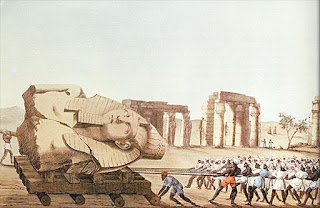The Great Belzoni’s powerful physique helped him remove Egyptian treasures
 |
| Giovanni Battista Belzoni during his time as an archaeologist in Egypt |
Belzoni became famous for his height and strength and his discovery and removal to England of the seven-ton bust of Ramesses II.
Born into a poor family, at the age of 16 he went to find work in Rome and studied hydraulics. He was planning to take monastic vows but in 1798 French troops occupied the city and he moved to the Batavian Republic, now the Netherlands, where he earned his living as a barber.
He moved to England in 1803, allegedly to escape going to prison. He was six feet seven inches tall and had a powerful physique. For a while he earned his living as a circus strong man under the name The Great Belzoni.
He also exhibited his models of hydraulic engines and went to Cairo in 1815 to offer hydraulic engines for use in irrigation to Muhammad Ali Pasha, the founder of modern Egypt.
But two years later he embarked on another new career, excavating Egyptian tombs and temples for their treasures. It was said he damaged other less valuable objects in the process, which was later frowned upon.
 |
| It took 17 days for 130 men to tow the bust of Ramesses II to a boat bound for England |
While he was in the process of removing an obelisk from the Nile island of Philae, it was taken from him at gunpoint by men working for the French.
He explored an island in the Nile, known as Elephantine, and the temple of Edfu. He also cleared the entrance to the great temple of Ramasses II at Abu Simbel. He was the first to penetrate the pyramid of Khafre at Giza and he identified the ruins of the city of Berenice on the Red Sea.
Belzoni returned to England in 1819 and published an account of his adventure – Narratives of the Operations and Recent Discoveries Within the Pyramids, Temples, Tombs and Excavations in Egypt and Nubia. It was a two-volume work published in 1820.
The explorer and archaeologist died in 1823 at the age of 45 in Gwato, now called Ughoton, in Nigeria on his way to Timbuktu. In 1825 Belzoni’s widow exhibited his drawings and models of the Royal tombs of Thebes in London and Paris.
There is a road named after Belzoni - the Via Giambattista Belzoni - to the east of Padua's city centre.
No comments:
Post a Comment